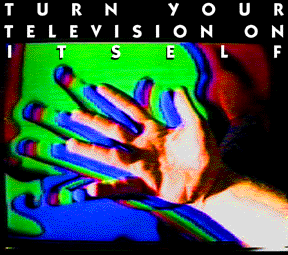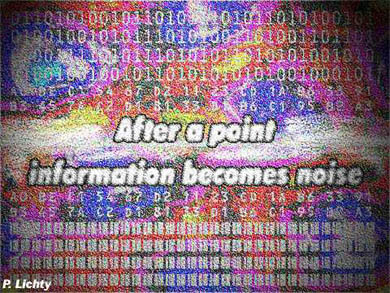The Video Feedback Case.
Matthew Hutson, English 111, Brown University (1998)

On New Year's Eve 1996, I met a guy named Toshi Hoo at a rave called Escape. He was wearing his new fireproof silver pants, and I was wearing my normal silver fireproof coat. I approached him and commented on his handsome pants, and that's how I first met him. He told me about his group of video-performist artists (a term I had not heard before) and their work. Noise Laboratories, of Boston, was a group of 8 guys (some have gone their own ways since) who pooled their interests, resources, and talents to experiment with interaction, electronics, and noise. Self-titled "Data Integrity Engineer" Matt LaMantia describes Noise Laboratories as "providing creative decoding schemes for information from our environment that is normally classified as noise."
So anyway, Toshi told me that they perform occasionally at a series of parties called ToneBurst. These parties, usually costing about five dollars and going from 9 until 2, are full of eclectic artists and groups performing live electronic performances, spoken word pieces, audio/visual displays, and interactive technologies. So I went to ToneBurst party with three friends, not knowing what to expect, and that night I experienced a most revolutionary dance with abstraction: video feedback.
Upon approaching Noise Laboratories' area of the room, I saw a big screen with lots of weird stuff projected on it, a group of mattresses covered with people holding video cameras, a bunch of TV sets displaying different moving images, and a few guys in lab coats playing with a video mixer. I took me a while to figure out exactly what was going on.
This is how they set it up: The final big screen came from a TV set that had the output from two different TV sets mixed together. Each of these two TV sets had three different TV's sending it their output, also combined with a mixer. So the final picture was a constantly morphing mixture of six different inputs. Three of the inputs came from video feedback loops; people sat on the mattresses and pointed the cameras at TV's that were displaying what the cameras pointed at them were recording. More people were sitting between the cameras and the TV sets and planting seeds of visual stimulation within the feedback process, i.e. blowing bubbles and shining small flashlights at the screens etc. At this point it still did not register in my head what was creating the complex geometrical patterns displayed on some of the many screens. I had thought they were some kind of cool computer program that was mixed in, but when I asked Toshi, he told me it was feedback, pure and simple.

The power of feedback eluded me until I actually sat down and started playing with a camera. At first, it's incredibly hard to administer any kind of control over the process; small changes would escalate wildly and sweep across the entire screen in the time it takes to blink.
So I'm sitting in front of the TV, pointing the camera at it, and I quickly learn that if I point the camera towards a slightly darkened portion of the screen, the entire screen becomes black, and if I point the camera at a slightly lighter portion of the screen, everything goes white. One must then point the camera at something off-screen, or ask someone to create interference and get the process started again. Thus the technology acts as a positive feedback loop (like gravity on a tightrope walker's body) and I act as a negative feedback loop trying to stay balanced between the boredoms of complete whiteness and complete darkness. Eventually I experimented enough to develop the kind of subtlety required to navigate the continuously evolving landscape of the display, soaring freely through colors, dimensions, patterns, falling in and out of tight, complex geometrical patterns and sweeping through regions of utter chaos. Deftly surfing the abstract textures of pure noise, I gained a kind of freedom I had never felt in my life before, and I soon found fellow videonauts watching the screen with the same hypnotized look as myself.
Experiencing this kind of infinite freedom, I felt an unexplainable warmth towards analog technology of all kinds.
